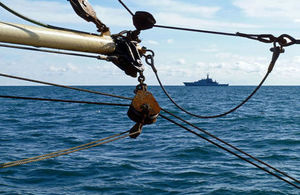Man found guilty of marine licensing offences relating to salvage of shipwreck
Tin ingots valued in excess of £50,000 were removed during unlawful salvage operations off the north coast of Cornwall.

On 20 May 2016, Mr Neil Isherwood of Bury, Lancashire was sentenced to a community order with 150 hours of unpaid work after being found guilty of a marine licensing offence by a jury at Newcastle upon Tyne Crown Court.
The court heard how Mr Isherwood was one of two responsible for the unlawful removal of tin ingots which were valued in excess of £50,000 from the shipwreck of the SS Cheerful, a cargo ship which sunk in 1885 off the north coast of Cornwall.
The defendant, together with Mr Henk de Bloeme, a Dutch national and the owner of the Panamanian registered vessel Bela, had set off from Holland on 15 July 2013 and over the course of the next fortnight visited a number of wrecks situated around the coast of the United Kingdom.
On 1 August 2013, the MV Bela was intercepted by HMS Severn and boarded by marine officers from the Marine Management Organisation (MMO) working with the Royal Navy. On board, the officers identified a quantity of tin ingots which further investigation revealed had been salvaged from the wreck of the SS Cheerful. Further investigation also revealed that the defendants did not have a marine licence authorising the removal.
Under the Marine and Coastal Access Act 2009, a marine licence is required for the removal of any substance or object from the sea bed in the UK marine area using a vehicle, vessel or other marine structure. In English waters, the MMO is the licensing authority.
The court also heard how Mr De Bloeme had previously pleaded guilty to the offence at North Tyneside Magistrates’ Court on 29 May 2015 for which he received a £2,000 fine and was ordered to pay a proportion of the prosecution costs.
Mr Isherwood, who told the court he was a self-employed cargo recovery consultant based in Manchester, had previously pleaded not guilty to the offences and asked that the case be tried by the Crown Court. After a four day trial in Newcastle the jury returned a unanimous guilty verdict. Sentencing Mr Isherwood the Recorder of Newcastle, His Honour Judge Sloan QC, said: “I have no doubt that you played a leading role in this exercise. The offence was committed deliberately and I am satisfied that you attempted to conceal your activities.”
In bringing this prosecution, the MMO was supported by Royal Navy officers from the Fisheries Protection Squadron who took part in the boarding of the vessel and provided valuable evidence to the court. The prosecution was also supported by Historic England, from whom Dr Christopher Pater gave expert evidence as to the provenance and historic value of the tin ingots which were salvaged from the wreck and also told the court of the harm that can be caused to sites of important archaeological value from unregulated salvage activities.
Dr Christopher Pater, Head of Marine Planning for Historic England said:
“This has been an important case for Historic England to support the Marine Management Organisation because it is essential that when individuals target historic shipwrecks for unlawful salvage, we can provide vital information about how a wreck like the SS Cheerful is part of our shared heritage. The SS Cheerful dates from a time when steam power was replacing sail and tin ingot smelting in Cornwall was an active industry, so it is a loss to us all if sites like this are picked apart and the wreck and its contents lost piece by piece.”
The MMO endeavours to achieve compliance with marine licensing requirements through a number of responses in accordance with its compliance and enforcement strategy. Guidance is available on the MMO website on the process of obtaining a licence and the MMO encourages people who have queries to make contact if further guidance is required. This case demonstrates the MMO’s determination to try and prevent unlawful salvage operations in the UK marine licensing area to protect the environment and maritime archaeological heritage.